LEVULAN KERASTICK
Levulan® Kerastick®(aminolevulinic acid HCl) for Topical Solution, 20% For Topical Use Only Not for Opthalmic Use
FULL PRESCRIBING INFORMATION: CONTENTS*
- LEVULAN KERASTICK DESCRIPTION
- CLINICAL PHARMACOLOGY
- Clinical Studies
- LEVULAN KERASTICK INDICATIONS AND USAGE
- LEVULAN KERASTICK CONTRAINDICATIONS
- WARNINGS
- PRECAUTIONS
- LEVULAN KERASTICK ADVERSE REACTIONS
- OVERDOSAGE
- LEVULAN KERASTICK DOSAGE AND ADMINISTRATION
- HOW SUPPLIED
FULL PRESCRIBING INFORMATION
DESCRIPTION
LEVULAN® KERASTICK® (aminolevulinic acid HCl) for Topical Solution, 20%, contains the hydrochloride salt of aminolevulinic acid (ALA), an endogenous 5-carbon aminoketone.
Aminolevulinic acid HCl (ALA HCl) is a white to off-white, odorless crystalline solid that is very soluble in water, slightly soluble in methanol and ethanol, and practically insoluble in chloroform, hexane and mineral oil.
The chemical name for ALA HCl is 5-amino-4-oxopentanoic acid hydrochloride (MW = 167.59). The structural formula is represented below:
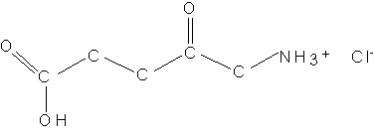
The LEVULAN KERASTICK for Topical Solution applicator is a two component system consisting of a plastic tube containing two sealed glass ampules and an applicator tip. One ampule contains 1.5 mL of solution vehicle comprising alcohol USP (ethanol content = 48% v/v), water, laureth-4, isopropyl alcohol, and polyethylene glycol. The other ampule contains 354 mg of ALA HCl as a dry solid. The applicator tube is enclosed in a protective cardboard sleeve and cap. The 20% topical solution is prepared just prior to the time of use by breaking the ampules and mixing the contents by shaking the LEVULAN KERASTICK applicator. The term “ALA HCl” refers to unformulated active ingredient, “LEVULAN KERASTICK for Topical Solution” refers to the drug product in its unmixed state, “LEVULAN KERASTICK Topical Solution” refers to the mixed drug product (in the applicator tube or after application), and “LEVULAN KERASTICK” refers to the applicator only.
CLINICAL PHARMACOLOGY
Pharmacology
The metabolism of aminolevulinic acid ( ALA) is the first step in the biochemical pathway resulting in heme synthesis. Aminolevulinic acid is not a photosensitizer, but rather a metabolic precursor of protoporphyrin IX (PpIX), which is a photosensitizer. The synthesis of ALA is normally tightly controlled by feedback inhibition of the enzyme, ALA synthetase, presumably by intracellular heme levels. ALA, when provided to the cell, bypasses this control point and results in the accumulation of PpIX, which is converted into heme by ferrochelatase through the addition of iron to the PpIX nucleus.
According to the presumed mechanism of action, photosensitization following application of LEVULAN KERASTICK Topical Solution occurs through the metabolic conversion of ALA to PpIX, which accumulates in the skin to which LEVULAN Topical Solution has been applied. When exposed to light of appropriate wavelength and energy, the accumulated PpIX produces a photodynamic reaction, a cytotoxic process dependent upon the simultaneous presence of light and oxygen. The absorption of light results in an excited state of the porphyrin molecule, and subsequent spin transfer from PpIX to molecular oxygen generates singlet oxygen, which can further react to form superoxide and hydroxyl radicals. Photosensitization of actinic (solar) keratosis lesions using the LEVULAN KERASTICK, plus illumination with the BLU-U® Blue Light Photodynamic Therapy Illuminator (BLU-U), is the basis for LEVULAN photodynamic therapy (PDT).
Pharmacokinetics
In a human pharmacokinetic study (N=6) using a 128 mg dose of sterile intravenous ALA HCl and oral ALA HCl (equivalent to 100 mg ALA) in which plasma ALA and PpIX were measured, the mean half-life of ALA was 0.70 ± 0.18 h after the oral dose and 0.83 ± 0.05 h after the intravenous dose. The oral bioavailability of ALA was 50-60% with a mean Cmax of 4.65 ± 0.94 µg/mL. PpIX concentrations were low and were detectable only in 42% of the plasma samples. PpIX concentrations in plasma were quite low relative to ALA plasma concentrations, and were below the level of detection (10 ng/mL) after 10 to 12 hours.
ALA does not exhibit fluorescence, while PpIX has a high fluorescence yield. Time-dependent changes in surface fluorescence have been used to determine PpIX accumulation and clearance in actinic keratosis lesions and perilesional skin after application of LEVULAN KERASTICK Topical Solution in 12 patients. Peak fluorescence intensity was reached in 11 ± 1 h in actinic keratoses and 12 ± 1 h in perilesional skin. The mean clearance half-life of fluorescence for lesions was 30 ± 10 h and 28 ± 6 h for perilesional skin. The fluorescence in perilesional skin was similar to that in actinic keratoses. Therefore, LEVULAN KERASTICK Topical Solution should only be applied to the affected skin.
Clinical Studies
LEVULAN KERASTICK for Topical Solution, 20%, plus blue light at 6-10.9 J/cm2, has been used to treat actinic keratoses in 232 patients in six clinical trials. Phase 3 studies were two, identically designed, multicenter, two-arm studies using LEVULAN KERASTICK for Topical Solution applicators plus illumination from the BLU-U for 1000 seconds (16 min 40 sec) for a nominal exposure of 10 J/cm2. Patients were excluded from these studies who had a history of cutaneous photosensitization, porphyria, hypersensitivity to porphyrins, photodermatosis, or inherited or acquired coagulation defects. A minimum of 4 and a maximum of 15 clinically typical, discrete, (Grade 1 or 2, see table 2 for definition), target actinic keratosis lesions were identified. Target lesions on the face or on the scalp, but not in both locations in the same patient, received treatment. The patients were randomized to receive treatment either with the LEVULAN KERASTICK Topical Solution plus BLU-U or vehicle plus BLU-U. Patients were randomized at a 3 to 1 LEVULAN to vehicle ratio. A total of 243 patients were enrolled in two Phase 3 studies (ALA-018, ALA-019). Lesions were designated as cleared (complete response) if the lesion had completely cleared and adherent scaling plaques of actinic keratoses were no longer evident on the surface of the treated skin when palpated. The percentage of patients in whom 75% or more of treated lesions were cleared, and the percentage of patients in whom 100% of treated lesions were cleared (Complete Responders), for each study at 8 weeks after treatment are shown in Table 1.
| ALA-018 | ALA-019 | |||||
| LEVULAN | Vehicle | LEVULAN | Vehicle | |||
| Patients with > 75% of AK Lesions Cleared | ||||||
| Total No. Patients | 68/87 (78%) | 6/29 (21%) | 71/93 (76%) | 8/32 (25%) | ||
| Patients with Face Lesions | 57/71 (80%) | 2/21 (10%) | 57/67 (85%) | 7/19 (37%) | ||
| Patients with Scalp Lesions | 11/16 (69%) | 4/8 (50%) | 14/26 (54%) | 1/13 (8%) | ||
| Complete Responders | ||||||
| Total No. Patients | 60/87 (69%) | 4/29 (14%) | 59/93 (63%) | 4/32 (13%) | ||
| Patients with Face Lesions | 49/71 (69%) | 2/21 (10%) | 47/67 (70%) | 4/19 (21%) | ||
| Patients with Scalp Lesions | 11/16 (69%) | 2/8 (25%) | 12/26 (46%) | 0/13 (0%) | ||
Because clinical studies ALA-018 and ALA-019 had identical protocols, the combined results from the two trials are shown in the following tables. For actinic keratoses with a variety of thicknesses (excluding very thick, Grade 3 actinic keratoses which were not studied in the phase 3 trials), LEVULAN KERASTICK Topical Solution plus BLU-U is more effective than vehicle plus BLU-U, but as shown in Table 2, the percentage of lesions with complete responses at 8 weeks after treatment with LEVULAN KERASTICK Topical Solution plus blue light illumination was lower for those lesions that were thicker at baseline. Efficacy of LEVULAN KERASTICK Topical Solution plus BLU-U on higher grade lesions was not studied in the Phase 3 clinical efficacy trials.
| LEVULAN | Vehicle | |
| Lesion Grade 1 (Slightly palpable actinic keratoses: better felt than seen) | 666/756 (88%) | 122/302 (40%) |
| Lesion Grade 2 (Moderately thick actinic keratoses: easily seen and felt) | 495/632 (78%) | 52/199 (26%) |
| Lesion Grade 3 (Very Thick and/or hyperkeratotic actinic keratoses) | 0 | 0 |
Those patients who were not Complete Responders at week 8 had retreatment of the persistent target lesions at week 8. Among the patients undergoing retreatment, efficacy results seen at 12 weeks after the initial treatment, i.e., at 4 weeks after the second treatment, are shown in Table 3.
| LEVULAN | Vehicle | |
| Total No. Patients | 24/56 (43%) | 2/49 (4%) |
| Patients with Face Lesions | 21/40 (53%) | 2/31 (6%) |
| Patients with Scalp Lesions | 3/16 (19%) | 0/18 (0%) |
The efficacy results seen at 12 weeks after treatment, which include the results at 12 weeks for those patients who received a single treatment as well as the results at 12 weeks for those patients who received a second treatment at week 8, are shown in Table 4.
| LEVULAN | Vehicle | |
| Patients with > 75% of AK Lesions Cleared | ||
| Total No. Patients | 158/180 (88%) | 12/61 (20%) |
| Patients with Face Lesions | 127/138 (92%) | 8/40 (20%) |
| Patients with Scalp Lesions | 31/42 (74%) | 4/21 (19%) |
| Complete Responders | ||
| Total No. Patients | 129/180 (72%) | 7/61 (11%) |
| Patients with Face Lesions | 108/138 (78%) | 5/40 (13%) |
| Patients with Scalp Lesions | 21/42 (50%) | 2/21 (10%) |
Among Complete Responders at week 8, 93% (in study ALA-018) and 83% (in study ALA-019) maintained complete response at week 12. Among patients with scalp lesions, the percentage of patients with 100% of AK lesions having complete response declined from week 8 (55%) to week 12 (50%), because there were more patients with scalp lesions with 100% of AK lesions cleared at week 8 who had a recurrence of a lesion by week 12 than there were patients with scalp lesions who had retreatment of persistent lesions at week 8 and who then achieved 100% of AK lesions cleared by week 12. Patients did not receive follow-up past 12 weeks after the initial treatment.
Patient outcomes recorded in the two Phase 3 trials are depicted in the following flowchart, in which Complete Responders are designated clear. Seven patients in the active treatment arm and three patients in the vehicle treatment arm withdrew or were lost to follow-up, and their outcomes are not included in the flowchart. Three patients in the active treatment arm were treated at baseline but did not return for evaluation until week 12. One patient in the active treatment arm and two in the vehicle treatment arm who were not clear at week 8 did not receive retreatment.
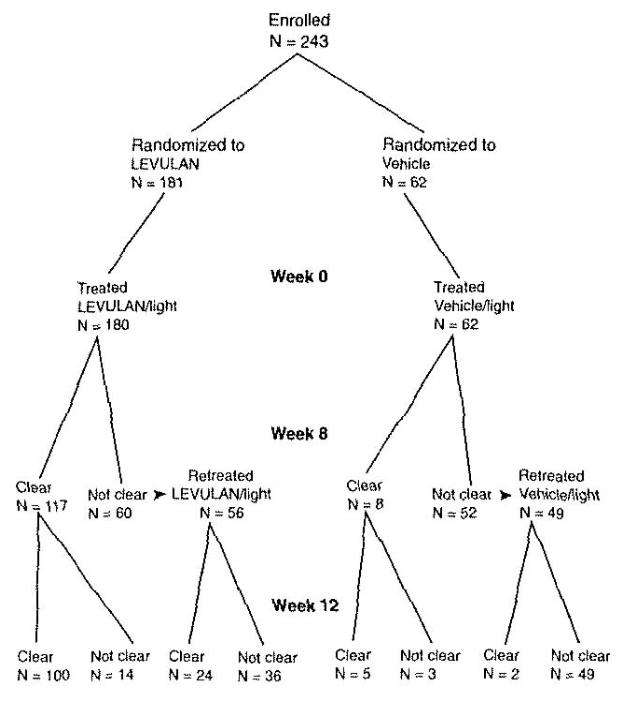
INDICATIONS AND USAGE
The LEVULAN KERASTICK for Topical Solution plus blue light illumination using the BLU-U Blue Light Photodynamic Therapy Illuminator is indicated for the treatment of minimally to moderately thick actinic keratoses (Grade 1 or 2, see table 2 for definition) of the face or scalp.
CONTRAINDICATIONS
The LEVULAN KERASTICK for Topical Solution plus blue light illumination using the BLU-U Blue Light Photodynamic Therapy Illuminator is contraindicated in patients with cutaneous photosensitivity at wavelengths of 400-450 nm, porphyria or known allergies to porphyrins, and in patients with known sensitivity to any of the components of the LEVULAN KERASTICK for Topical Solution.
WARNINGS
The LEVULAN KERASTICK for Topical Solution contains alcohol and is intended for topical use only. Do not apply to the eyes or to mucous membranes. Excessive irritation may be experienced if this product is applied under occlusion.
PRECAUTIONS
General
During the time period between the application of LEVULAN KERASTICK Topical Solution and exposure to activating light from the BLU-U Blue Light Photodynamic Therapy Illuminator, the treatment site will become photosensitive. After LEVULAN KERASTICK Topical Solution application, patients should avoid exposure of the photosensitive treatment sites to sunlight or bright indoor light (e.g., examination lamps, operating room lamps, tanning beds, or lights at close proximity) during the period prior to blue light treatment. Exposure may result in a stinging and/or burning sensation and may cause erythema and/or edema of the lesions. Before exposure to sunlight, patients should, therefore, protect treated lesions from the sun by wearing a wide-brimmed hat or similar head covering of light-opaque material. Sunscreens will not protect against photosensitivity reactions caused by visible light. It has not been determined if perspiration can spread the LEVULAN KERASTICK Topical Solution outside the treatment site to eye or surrounding skin.
Application of LEVULAN KERASTICK Topical Solution to perilesional areas of photodamaged skin of the face or scalp may result in photosensitization. Upon exposure to activating light from the BLU-U Blue Light Photodynamic Therapy Illuminator, such photosensitized skin may produce a stinging and/or burning sensation and may become erythematous and/or edematous in a manner similar to that of actinic keratoses treated with LEVULAN PDT. Because of the potential for skin to become photosensitized, the LEVULAN KERASTICK for Topical Solution should be used by a qualified health professional to apply drug only to actinic keratoses and not perilesional skin.
The LEVULAN KERASTICK for Topical Solution has not been tested on patients with inherited or acquired coagulation defects.
Information for Patients
LEVULAN Photodynamic Therapy for Actinic Keratoses.
The first step in LEVULAN KERASTICK photodynamic therapy (PDT) for actinic keratoses is application of the LEVULAN KERASTICK Topical Solution to actinic keratoses located on the patient’s face or scalp. After LEVULAN KERASTICK Topical Solution is applied to the actinic keratoses in the doctor’s office, the patient will be told to return the next day. During this time the actinic keratoses will become sensitive to light (photosensitive). Care should be taken to keep the treated actinic keratoses dry and out of bright light. After LEVULAN KERASTICK Topical Solution is applied, it is important for the patient to wear light-protective clothing, such as a wide-brimmed hat, when exposed to sunlight or sources of light. Fourteen to eighteen hours after application of LEVULAN KERASTICK Topical Solution the patient will return to the doctor’s office to receive blue light treatment, which is the second and final step in the treatment. Prior to blue light treatment, the actinic keratoses will be rinsed with tap water. The patient will be given goggles to wear as eye protection during the blue light treatment. The blue light is of low intensity and will not heat the skin. However, during the light treatment, which lasts for approximately 17 minutes, the patient will experience sensations of tingling, stinging, prickling or burning of the treated lesions. These feelings of discomfort should improve at the end of the light treatment. Following treatment, the actinic keratoses and, to some degree, the surrounding skin, will redden, and swelling and scaling may also occur. However, these lesion changes are temporary and should completely resolve by 4 weeks after treatment.
Photosensitivity
After LEVULAN KERASTICK Topical Solution is applied to the actinic keratoses in the doctor’s office, the patient should avoid exposure of the photosensitive actinic keratoses to sunlight or bright indoor light (e.g., from examination lamps, operating room lamps, tanning beds, or lights at close proximity) during the period prior to blue light treatment. If the patient feels stinging and/or burning on the actinic keratoses, exposure to light should be reduced. Before going into sunlight, the patient should protect treated lesions from the sun by wearing a wide-brimmed hat or similar head covering of light-opaque material. Sunscreens will not protect the patient against photosensitivity reactions.
If for any reason the patient cannot return for blue light treatment during the prescribed period after application of LEVULAN KERASTICK Topical Solution (14 to 18 hours), the patient should call the doctor. The patient should also continue to avoid exposure of the photosensitized lesions to sunlight or prolonged or intense light for at least 40 hours. If stinging and/or burning is noted, exposure to light should be reduced.
Drug Interactions
There have been no formal studies of the interaction of LEVULAN KERASTICK for Topical Solution with any other drugs, and no drug-specific interactions were noted during any of the controlled clinical trials. It is, however, possible that concomitant use of other known photosensitizing agents such as griseofulvin, thiazide diuretics, sulfonylureas, phenothiazines, sulfonamides and tetracyclines might increase the photosensitivity reaction of actinic keratoses treated with the LEVULAN KERASTICK for Topical Solution.
Carcinogenesis, Mutagenesis, Impairment to Fertility
No carcinogenicity testing has been carried out using ALA. No evidence of mutagenic effects was seen in four studies conducted with ALA to evaluate this potential. In the Salmonella-Escherichia coli/mammalian microsome reverse mutation assay (Ames mutagenicity assay), no increases in the number of revertants were observed with any of the tester strains. In the Salmonella-Escherichia coli/mammalian microsome reverse mutation assay in the presence of solar light radiation (Ames mutagenicity assay with light), ALA did not cause an increase in the number of revertants per plate of any of the tester strains in the presence or absence of simulated solar light. In the L5178Y TK± mouse lymphoma forward mutation assay, ALA was evaluated as negative with and without metabolic activation under the study conditions. PpIX formation was not demonstrated in any of these in vitro studies. In the in vivo mouse micronucleus assay, ALA was considered negative under the study exposure conditions. In contrast, at least one report in the literature has noted genotoxic effects in cultured rat hepatocytes after ALA exposure with PpIX formation. Other studies have documented oxidative DNA damage in vivo and in vitro as a result of ALA exposure.
No assessment of effects of ALA HCl on fertility has been performed in laboratory animals. It is unknown what effects systemic exposure to ALA HCl might have on fertility or reproductive function.
Pregnancy Category C
Animal reproduction studies have not been conducted with ALA HCl. It is also not known whether LEVULAN KERASTICK Topical Solution can cause fetal harm when administered to a pregnant woman or can affect reproductive capacity. LEVULAN KERASTICK Topical Solution should be given to a pregnant woman only if clearly needed.
Nursing Mothers
The levels of ALA or its metabolites in the milk of subjects treated with LEVULAN KERASTICK Topical Solution have not been measured. Because many drugs are excreted in human milk, caution should be exercised when LEVULAN KERASTICK Topical Solution is administered to a nursing woman.
ADVERSE REACTIONS
In Phase 3 studies, no non-cutaneous adverse events were found to be consistently associated with LEVULAN KERASTICK Topical Solution application followed by blue light exposure.
Photodynamic Therapy Response
The constellation of transient local symptoms of stinging and/or burning, itching, erythema and edema as a result of LEVULAN KERASTICK Topical Solution plus BLU-U treatment was observed in all clinical studies of LEVULAN KERASTICK for Topical Solution Photodynamic Therapy for actinic keratoses treatment. Stinging and/or burning subsided between 1 minute and 24 hours after the BLU-U Blue Light Photodynamic Therapy Illuminator was turned off, and appeared qualitatively similar to that perceived by patients with erythropoietic protoporphyria upon exposure to sunlight. There was no clear drug dose or light dose dependent change in the incidence or severity of stinging and/or burning.
In two Phase 3 trials, the sensation of stinging and/or burning appeared to reach a plateau at 6 minutes into the treatment. Severe stinging and/or burning at one or more lesions being treated was reported by at least 50% of the patients at some time during treatment. The majority of patients reported that all lesions treated exhibited at least slight stinging and/or burning. Less than 3% of patients discontinued light treatment due to stinging and/or burning.
The most common changes in lesion appearance after LEVULAN KERASTICK Topical Solution Photodynamic Therapy were erythema and edema. In 99% of active treatment patients, some or all lesions were erythematous shortly after treatment, while in 79% of vehicle treatment patients, some or all lesions were erythematous. In 35% of active treatment patients, some or all lesions were edematous, while no vehicle-treated patients had edematous lesions. Both erythema and edema resolved to baseline or improved by 4 weeks after therapy. LEVULAN KERASTICK Topical Solution application to photodamaged perilesional skin resulted in photosensitization of photodamaged skin and in a photodynamic response. (see Precautions).
Other Localized Cutaneous Adverse Experiences
Table 5 depicts the incidence and severity of cutaneous adverse events, stratified by anatomic site treated.
| FACE | SCALP | |||||||
| LEVULAN (n=139) | Vehicle (n=41) | LEVULAN (n=42) | Vehicle (n=21) | |||||
| Degree of Severity | Mild/ Moderate | Severe | Mild/ Moderate | Severe | Mild/ Moderate | Severe | Mild/ Moderate | Severe |
| Scaling/Crusting | 71% | 1% | 12% | 0% | 64% | 2% | 19% | 0% |
| Pain | 1% | 0% | 0% | 0% | 0% | 0% | 0% | 0% |
| Tenderness | 1% | 0% | 0% | 0% | 2% | 0% | 0% | 0% |
| Itching | 25% | 1% | 7% | 0% | 14% | 7% | 19% | 0% |
| Edema | 1% | 0% | 0% | 0% | 0% | 0% | 0% | 0% |
| Ulceration | 4% | 0% | 0% | 0% | 2% | 0% | 0% | 0% |
| Bleeding/Hemorrhage | 4% | 0% | 0% | 0% | 2% | 0% | 0% | 0% |
| Hypo/hyper-pigmentation | 22% | 20% | 36% | 33% | ||||
| Vesiculation | 4% | 0% | 0% | 0% | 5% | 0% | 0% | 0% |
| Pustules | 4% | 0% | 0% | 0% | 0% | 0% | 0% | 0% |
| Oozing | 1% | 0% | 0% | 0% | 0% | 0% | 0% | 0% |
| Dysesthesia | 2% | 0% | 0% | 0% | 0% | 0% | 0% | 0% |
| Scabbing | 2% | 1% | 0% | 0% | 0% | 0% | 0% | 0% |
| Erosion | 14% | 1% | 0% | 0% | 2% | 0% | 0% | 0% |
| Excoriation | 1% | 0% | 0% | 0% | 0% | 0% | 0% | 0% |
| Wheal/Flare | 7% | 1% | 0% | 0% | 2% | 0% | 0% | 0% |
| Skin disorder NOS | 5% | 0% | 0% | 0% | 12% | 0% | 5% | 0% |
Adverse Experiences Reported by Body System
In the Phase 3 studies, 7 patients experienced a serious adverse event. All were deemed remotely or not related to treatment. No clinically significant patterns of clinical laboratory changes were observed for standard serum chemical or hematologic parameters in any of the controlled clinical trials.
OVERDOSAGE
LEVULAN KERASTICK Topical Solution Overdose
LEVULAN KERASTICK Topical Solution overdose have not been reported. In the unlikely event that the drug is ingested, monitoring and supportive care are recommended. The patient should be advised to avoid incidental exposure to intense light sources for at least 40 hours. The consequences of exceeding the recommended topical dosage are unknown.
BLU-U® Light Overdose
There is no information on overdose of blue light from the BLU-U Blue Light Photodynamic Therapy Illuminator following LEVULAN KERASTICK Topical Solution application.
DOSAGE AND ADMINISTRATION
LEVULAN KERASTICK for Topical Solution 20% is intended for direct application to individual lesions diagnosed as actinic keratoses and not to perilesional skin. This product is not intended for application by patients or unqualified medical personnel. Application should involve either scalp or face lesions, but not both simultaneously. The recommended treatment frequency is: one application of the LEVULAN KERASTICK Topical Solution and one dose of illumination per treatment site per 8-week treatment session. Each individual LEVULAN KERASTICK should be used for only one patient. Photodynamic therapy for actinic keratoses with LEVULAN KERASTICK for Topical Solution is a two stage process involving a) application of the product to the target lesions with LEVULAN KERASTICK Topical Solution, followed 14 to 18 hours later by b) illumination with blue light using the BLU-U Blue Light Photodynamic Therapy Illuminator. The second visit, for illumination, must take place in the 14-18 hour window following application. Patients in clinical trials usually received application in the late afternoon, with illumination the following morning.
|
LEVULAN KERASTICK Topical Solution Application | Time Window for Blue Light Illumination |
| 6 am | 8 pm to Midnight |
| 7 am | 9 pm to 1 am |
| 8 am | 10 pm to 2 am |
| 9 am | 11 pm to 3 am |
| 10 am | Midnight to 4 am |
| 11 am | 1 am to 5 am |
| 12 pm | 2 am to 6 am |
| 1 pm | 3 am to 7 am |
| 2 pm | 4 am to 8 am |
| 3 pm | 5 am to 9 am |
| 4 pm | 6 am to 10 am |
| 5 pm | 7 am to 11 am |
| 6 pm | 8 am to Noon |
| 7 pm | 9 am to 1 pm |
| 8 pm | 10 am to 2 pm |
| 9 pm | 11 am to 3 pm |
| 10 pm | Noon to 4 pm |
Treated lesions that have not completely resolved after 8 weeks may be treated a second time with LEVULAN KERASTICK for Topical Solution Photodynamic Therapy. Patients did not receive follow-up past 12 weeks after the initial treatment, so the incidence of recurrence of treated lesions past 12 weeks and the role of further treatment is not known.
Step A - LEVULAN KERASTICK for Topical Solution Application
Actinic keratoses targeted for treatment should be clean and dry prior to application of LEVULAN KERASTICK for Topical Solution.
Preparation:
The LEVULAN KERASTICK Topical Solution should be prepared as follows:
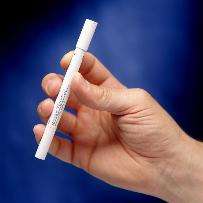
| 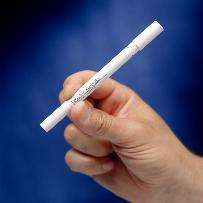
|
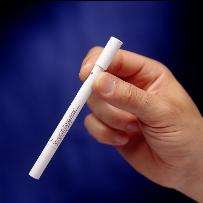
| 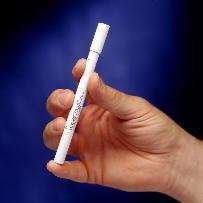
|
LEVULAN KERASTICK Preparation: Following solution admixture, remove the cap from the LEVULAN KERASTICK. The dry applicator tip should be dabbed on a gauze pad until uniformly wet with solution.
Application:
Apply the solution directly to the target lesions by dabbing gently with the wet applicator tip. Enough solution should be applied to uniformly wet the lesion surface, including the edges without excess running or dripping. The effect of LEVULAN KERASTICK Topical Solution on ocular tissues is unknown. LEVULAN KERASTICK Topical Solution should not be applied to the periorbital area or allowed to contact ocular or mucosal surfaces. Once the initial application has dried, apply again in the same manner. The LEVULAN KERASTICK Topical Solution must be used immediately following preparation (dissolution) due to the instability of the activated product. If the solution application is not completed within 2 hours of activation, the applicator should be discarded and a new LEVULAN KERASTICK for Topical Solution used.
Photosensitization of the treated lesions will take place over the next 14-18 hours. The actinic keratoses should not be washed during this time. The patient should be advised to wear a wide-brimmed hat or other protective apparel to shade the treated actinic keratosis lesions from sunlight or other bright light sources until BLU-U treatment. The patient should be advised to reduce light exposure if the sensations of stinging and/or burning are experienced.
If for any reason the patient cannot be given BLU-U treatment during the prescribed time after LEVULAN KERASTICK Topical Solution application, he or she may nonetheless experience sensations of stinging and/or burning if the photosensitized actinic keratoses are exposed to sunlight or prolonged or intense light at that time. The patient should be advised to wear a wide-brimmed hat or other protective apparel to shade the treated actinic keratosis lesions from sunlight or other bright light sources until at least 40 hours after the application of LEVULAN KERASTICK Topical Solution. The patient should be advised to reduce light exposure if the sensations of stinging and/or burning are experienced.
Step B - Administration of BLU-U Treatment 14 to 18 hours after application of LEVULAN KERASTICK Topical Solution
At the visit for light illumination, the actinic keratoses to be treated should be gently rinsed with water and patted dry. Photoactivation of actinic keratoses treated with LEVULAN KERASTICK Topical Solution is accomplished with BLU-U illumination from the BLU-U Blue Light Photodynamic Therapy Illuminator. A 1000 second (16 minutes 40 seconds) exposure is required to provide a 10 J/cm2 light dose. During light treatment, both patients and medical personnel should be provided with blue blocking protective eyewear, as specified In the BLU-U Operating Instructions, to minimize ocular exposure. Please refer to the BLU-U Operating Instructions for further information on conducting the light treatment. Patients should be advised that transient stinging and/or burning at the target lesion sites occurs during the period of light exposure.
If blue light treatment with the BLU-U Blue Light Photodynamic Therapy Illuminator is interrupted or stopped for any reason, it should not be restarted and the patient should be advised to protect the treated lesions from exposure to sunlight or prolonged or intense light for at least 40 hours after application of the LEVULAN KERASTICK Topical Solution from the first visit.
For patients with facial lesions:
- The BLU-U Blue Light Photodynamic Therapy Illuminator is positioned so that the base is slightly above the patient’s shoulder, parallel to the patient’s face.
- The BLU-U is positioned around the patient’s head so the entire surface area to be treated lies between 2” and 4” from the BLU-U surface:
a) The patient’s nose should be no closer than 2” from the surface;b) The patient’s forehead and cheeks should be no further than 4” from the surface;c) The sides of the patient’s face and the patient’s ears should be no closer than 2” from the BLU-U surface.
A Chin Rest, available from DUSA Pharmaceuticals, Inc., may be used to provide support for the patient’s head during treatment.
For patients with scalp lesions:
- The knobs on either side of the BLU-U are loosened and the BLU-U is rotated to a horizontal position.
- The BLU-U is positioned around the patient’s head so the entire surface area to be treated lies between 2” and 4” from the BLU-U surface:
a) The patient’s scalp should be no closer than 2” from the surface;b) The patient’s scalp should be no further than 4” from the surface;c) The sides of the patient’s face and the patient’s ears should be no closer than 2” from the BLU-U surface.
A Chin Rest, available from DUSA Pharmaceuticals, Inc., may be used to provide support for the patient’s head during treatment.
LEVULAN KERASTICK for Topical Solution is not intended for use with any device other than the BLU-U Blue Light Photodynamic Therapy Illuminator. Use of LEVULAN KERASTICK for Topical Solution without subsequent BLU-U illumination is not recommended.
HOW SUPPLIED
The LEVULAN KERASTICK for Topical Solution, 20%, is a single-unit dosage form, supplied in packs of 6. Each LEVULAN KERASTICK for Topical Solution applicator consists of a plastic tube containing two sealed glass ampules and an applicator tip. One ampule contains 1.5 mL of solution vehicle. The other ampule contains 354 mg of aminolevulinic acid HCl. The applicator is covered with a protective cardboard sleeve and cap.
| Product Package | NDC number |
| Individual LEVULAN KERASTICK for Topical Solution, 20% | 67308-101-01 |
| Carton of 6 LEVULAN KERASTICKS for Topical Solution, 20% | 67308-101-06 |
Storage Conditions: Store between 20° - 25 °C (68° - 77 °F); excursions permitted to 15°- 30 °C (59° - 86 °F) [See USP Controlled Room Temperature]. The LEVULAN KERASTICK for Topical Solution should be used immediately following preparation (dissolution). Solution application must be completed within 2 hours of preparation. An applicator that has been prepared must be discarded 2 hours after mixing (dissolving) and a new LEVULAN KERASTICK for Topical Solution used, if needed.
Rx
LEVULAN®, KERASTICK®, BLU-U®, DUSA Pharmaceuticals, Inc.® and DUSA® are registered trademarks of DUSA Pharmaceuticals, Inc.®
US Patents: 5,079,262, 5,211,938, 5,422,093, 5,954,703, 6,710,066
| Manufactured for: | DUSA Pharmaceuticals, Inc.® 25 Upton Drive Wilmington MA 01887 |
| Revision: F | LAB-0530 |
For more information please contact:

1-877-533-3872
or
1-978-657-7500
www.dusapharma.com
LEVULAN KERASTICKAminolevulinic acid hydrochloride KIT
| ||||||||||||||||||||||||||||||||